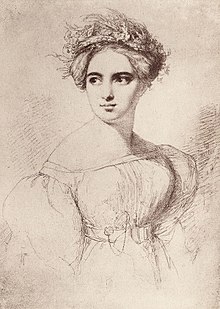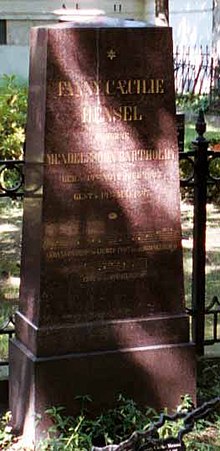This is an old revision of this page, as edited by Henry Flower (talk | contribs) at 17:09, 15 February 2006 (moved Fanny Hensel to Fanny Mendelssohn: usual name). The present address (URL) is a permanent link to this revision, which may differ significantly from the current revision.
Revision as of 17:09, 15 February 2006 by Henry Flower (talk | contribs) (moved Fanny Hensel to Fanny Mendelssohn: usual name)(diff) ← Previous revision | Latest revision (diff) | Newer revision → (diff)

Fanny Cäcilie Mendelssohn Bartholdy (November 14, 1805–May 14, 1847), later Fanny Hensel, was a German pianist and composer, and was the sister of Felix Mendelssohn.
Life
Fanny was born in Hamburg, the eldest child of Abraham Mendelssohn Bartholdy (son of the philosopher Moses Mendelssohn), and his wife Lea, née Salomon, a granddaughter of the entrepreneur Daniel Itzig. Fanny benefited from the same musical education and upbringing as her better known brother, sharing a number of his music tutors, including Zelter. Like Felix who was born in 1809, Fanny showed prodigious musical ability as a child and began to write music. Visitors to the Mendelssohn household in the early 1820s, including Ignaz Moscheles and Sir George Smart, were equally impressed by both siblings. However, she was limited by prevailing attitudes of the time against women, attitudes apparently shared by her father and brother, who were tolerant, rather than supportive, of her activities as a composer. Her father wrote to her in 1820 'Music will perhaps become his profession, while for you it can and must be only an ornament'.
In 1829, after a courtship of several years, she married the painter Wilhelm Hensel who was supportive of her composing. Subsequently, her works were often played alongside her brother's at the family home in Berlin in the very popular concerts which were held there.
Her public debut at the piano came in 1838, when she played her brother's Piano Concerto No. 1.

Fanny composed over 450 pieces of music, most of them in secret. Her compositions include a piano trio and several books of solo piano pieces and songs. A number of her songs were originally published under Felix's name in his opus 8 and 9 collections. One of these songs , 'Italy', was a favorite of Queen Victoria, who thought Felix had written it. Her piano works are often in the manner of songs, and carry the name Lieder ohne Worte (Songs without Words). This style of piano work was most successfully developed by Felix Mendelssohn, though some modern scholars believe Fanny may have preceded him in the genre.
Fanny Mendelssohn-Hensel died in Berlin in 1847 of complications from a stroke suffered while rehearsing one of her brother's oratorios, 'The First Walpurgis Night'. In recent years, her music has become better known thanks to concert performances and a number of CDs being released on labels such as Hyperion and CPO. Her reputation has also been advanced by those researching female musical creativity, of which she is one of the relatively few exemplars in the early 19th century.
External Links
Works (under construction)
This is a partial list of recordings in the WorldCat database.
1818· aus der chronika eines fahrenden schülers
1820· 3 songs: 1 némorin; 2 vous, qui loin d’une amante; 3 sérénade de cortez
1822· sonata mv (E) allegro assai moderato
1823· 3 songs. die schöne müllerin: 1 des müllers blumen; 2 der neugierige; 3 die liebe farbe
1823· adagio
1824· ave maria
1824· sonata (c): 1 allegro moderato e con espressione; 2 andante con moto; 3 finale. presto
1825· 3 songs: 1 das heimweh; 2 italien; 3 suleika und hatem
1825· harfners lied
1825• 6 songs: 1 schwanenlied; 2 wanderlied; 3 warum sind denn die rosen so blaß?; 4 maienlied; 5 morgenständchen; 6 gondellied
1825• 4 pieces: 1 (G) lied
1825• 6 {piano} pieces: 4 (B)
1825• 6 songs: 1 nachtwanderer; 2 erwin; 3 frühling; 4 du bist die ruh; 5 bitte; 6 dein ist mein herz
1825• 4 pieces: 1 (b); 3 (D–)
1825• 6 songs: 1 die ersehnte; 2 ferne; 3 der rosenkranz; 4 die frühen gräber; 5 der maiabend; 6 die mainacht
1825• 5 songs: 1 nach süden; 2 vorwurf; 3 abendbild; 4 im herbste; 5 bergeslust
1825• pastorella
1825• wanderers nachtlied
1826· nähe des geliebten
1827· die schiffende
1827· wenn ich mir in stiller seele
1828· 2 pieces: 1 (g) fantasia; 2 (A–) capriccio
1829· 6 songs: 1 lebewhol; 2 grüner frühling, süsse mailust; 3 nun ist’s nicht öd; 4 o sprich, wo blieb dein heit’rer sinn?; 5 im hochland bruder; 6 wiedersehen
1829· liederkreis: 1 lebewhol; 2 grüner frühlihg; 3 nun ist’s nicht öd; 4 o sprich; 5 im hochland, bruder; 6 weidersehn
1829· prélude (F) wedding processional
1829· prélude (G) wedding recessional
1830· 3 songs: 1 sehnsucht; 2 verlust; 3 die nonne
1830· overture (C)
1831· oratorio nach bildern der bibel
1834· 3 songs: 1 once o’er my dark and troubled life; 2 i wander through the wood and weep; 3 what means the lonely tear
1834· string quartet (E–): 1 adagio ma non troppo; 2 allegretto; 3 romanze; 4 allegro molto vivace
1835· wenn der frühling kommt mit den sonnenschein
1836· 3 duets: 1 märz; 2 april; 3 mai
1836· 3 songs: 1 there be none of beauty’s daughters; 2 bright be the place of thy soul!; 3 farewell!
1836· 4 pieces: 1 (B–)
1836· suleika
1837· 3 duets: 1 wenn ich in deine augen sehe; 2 aus meinen tränen sprießen; 3 im wunderschönen monat mai
1837· ach, die augen sind es wieder
1838· 4 pieces: 1 (B–) allegretto grazioso; 2 (f) allegro agitato; 3 (C) prestissimo; 4 (F) allegro con spirito
1838· fichtenbaum und palme
1838· ich wandelte unter den bäumen
1838· notturno (g)
1839· hausgarten
1839· sehnsucht
1840· cavatina
1841· das jahr: 1 januar; 2 februar; 3 märz; 4 april; 5 mai; 6 juni; 7 juli; 8 august; 9 september; 10 oktober; 11 november; 12 dezember; 13 nachspiel
1843· dämmrung senkte sich von oben
1843· faust: part 2: act 1: anmutige gegend: 1 ariel’s song; 2 serenade; 3 notturno; 4 mattutino; 5 reveille
1843· sonata (g): 1 allegro molto agitato; 2 scherzo; 3 adagio; 4 finale. presto
1844· traum
1846· 6 songs: 1 im wald; 2 lockung; 3 waldeinsam; 4 morgengruß; 5 komm; 6 o herbst
1846· 4 pieces: 1 (?); 2 (?); 3 (F+) o traum der jugend, o goldner stern. andante cantabile; 4 (a) il salterello romano. allegro molto
1846· abendlich
1846· ariel
1846· im herbst
1846· lust’ge vögel
1846· morgenwanderung
1846· schilflied
1846· schon kehren die vögel
1846· schöne fremde
1846· schweigend sinkt die nacht
1846· schweigt der menschen laute lust
1846· wer will mir wehren zu singen
1847· 6 pieces: 2 (c+) melodie
1847· piano trio (d): 1 allegro molto vivace; 2 andante espressivo; 3 lied. allegretto; 4 finale. allegretto moderato
Sources
Fanny's son Sebastian Hensel edited the family correspondence as 'The Mendelssohn Family 1729-1847' (tr. into English, 4th revised edition 1884) which still remains an important source of information about Fanny, Felix and their relatives.
Fanny's correspondence with Felix has been translated into English and edited by Marcia Citron; 'The letters of Fanny Hensel to Felix Mendelssohn'(New York, 1987).
R. Larry Todd's 'Mendelssohn - A Life in Music' (Oxford 2003) ISBN 0195110439 is the most recent comprehensive survey of Felix and contains much information about Fanny.
Categories: